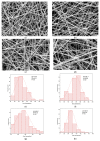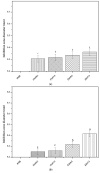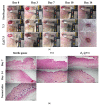Metronidazole Topically Immobilized Electrospun Nanofibrous Scaffold: Novel Secondary Intention Wound Healing Accelerator
- PMID: 35160444
- PMCID: PMC8840736
- DOI: 10.3390/polym14030454
Metronidazole Topically Immobilized Electrospun Nanofibrous Scaffold: Novel Secondary Intention Wound Healing Accelerator
Abstract
The process of secondary intention wound healing includes long repair and healing time. Electrospun nanofibrous scaffolds have shown potential for wound dressing. Biopolymers have gained much attention due to their remarkable characteristics such as biodegradability, biocompatibility, non-immunogenicity and nontoxicity. This study anticipated to develop a new composite metronidazole (MTZ) immobilized nanofibrous scaffold based on poly (3-hydroxy butyrate) (PHB) and Gelatin (Gel) to be utilized as a novel secondary intention wound healing accelerator. Herein, PHB and Gel were mixed together at different weight ratios to prepare polymer solutions with final concentration of (7%), loaded with two different concentrations 5% (Z1) and 10% (Z2) of MTZ. Nanofibrous scaffolds were obtained by manipulating electrospinning technique. The properties of MTZ immobilized PHB/Gel nanofibrous scaffold were evaluated (SEM, FTIR, TGA, water uptake, contact angle, porosity, mechanical properties and antibacterial activity). Additionally, in vitro cytocompatibility of the obtained nanofibrous scaffolds were assessed by using the cell counting kit-8 (CCK-8 assay). Moreover, in vivo wound healing experiments revealed that the prepared nanofibrous scaffold highly augmented the transforming growth factor (TGF-β) signaling pathway, moderately suppressed the pro-inflammatory cytokine (IL-6). These results indicate that MTZ immobilized PHB/Gel nanofibrous scaffold significantly boost accelerating secondary intention wound healing.
Keywords: antibacterial activity; biocompatibility; electrospinning; metronidazole; nanofibrous scaffold; secondary intention wound healing.
Conflict of interest statement
The authors declare no competing interest.
Figures













References
LinkOut - more resources
Full Text Sources

